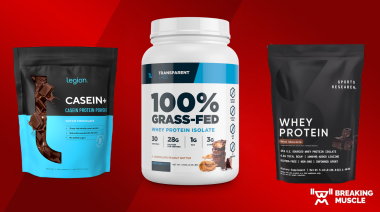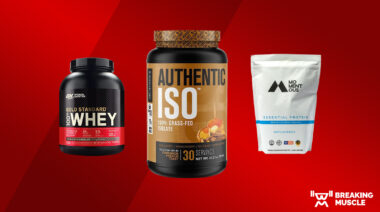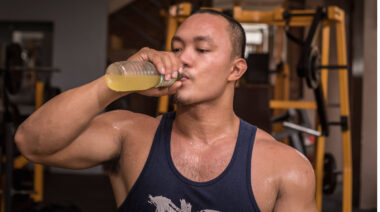It’s time to dispel a lot of the media hype currently associated with protein. Everyone out there seems to think there’s a new brand of protein powder that is going to magically transform them into a super athlete with less than 10% body fat. That with no dedication, commitment, or awareness, anyone can achieve the ideal body shape they so desire.
A lot of advertising out there will have you believe that the road to leanness is paved with protein shakes.
Sadly, protein in any form is not the “magic” macronutrient for body transformation. Protein is just one part of the nutritional requirements needed to achieve health goals. Following on from my article about sarcopenia and protein requirements for the ageing athlete, I thought it timely to discuss protein in a broader context: What protein is, what it’s not, what it does, and the practical application of its use.
What is Protein?
In its simplest form, protein is amino acids. There are twenty of these, and nine of them are considered essential amino acids (EAAs). EAAs are essential because the body does not produce them, so you need to consume them in liquid or food form to get them into your system. Now, of these nine EAAs, there are three branched chain amino acids (BCAAs). These are your most important amino acids as they are key regulators in muscle protein synthesis (MPS). One BCAA in particular, leucine, is viewed as the key amino acid for triggering muscle growth after exercise.1
Thus far, there is nothing magic about the mystical creature, protein – just some solid science.
What Can Protein Do for Athletes?
If you look at reviews and studies on protein and its effect on muscle building, improving body composition, and improving strength2-6, you will see clear evidence to support protein’s use. While the World Health Organization has a recommendation of 0.8g per kg of bodyweight for individual protein intake, the International Society of Sports Nutrition has a position stand that recommends 1.4-2g per kg of bodyweight for physically active individuals.2 This difference in recommendation is because protein breakdown is higher in training individuals, and should be supported with an increased intake.
What Can Protein Do for Body Composition?
Protein may have an effect on your body and your body composition5-7– but not a magical one.
Firstly, protein may reduce the total amount of food you are eating due to its ability to keep you feeling fuller for longer. On a higher protein diet, you can go into a calorie deficit without knowing it. This is one of the great practical applications of a higher protein diet for a lot of clients. Have you ever tried eating 400g of chicken compared to 400g of bread? Big difference in difficulty. This is a huge part of why higher protein diets work. Not because of all the fancy science behind protein’s effect on the body, but simply because most people cannot eat large volumes of food.
With that said, protein does have a greater thermic effect called TEF, or the thermic effect of feeding. In other words, your body works harder to break protein down and thus uses more energy to digest it. Protein is an uneconomical fuel source, but beneficial when used in the right manner. Protein has a TEF of approximately 19–23% in both obese and lean individuals, whereas carbohydrate has a TEF of approximately 12–14%. Studies investigating higher protein diets support that the majority of individuals (~70 %) who consume a high protein diet (>2 g/kg/bodyweight daily) get an improvement in body composition. This method is not 100% foolproof, but it does often work.
Protein also assists muscle protein synthesis. This means if you’re in a calorie deficit, there is potential for the muscle mass to be maintained whilst fat stores are utilized for energy. The parts of your body that aid metabolism are therefore maintained. When protein is combined with quality resistance training, then protein consumption starts to have a very significant effect on lean mass growth and fat loss.
Protein isn’t the key to muscle growth on its own. But without it, you won’t make significant strides in your pursuit of increased lean muscle and reduced body fat.
Protein in Action: A Case Study
Let’s take a look at a real life nutritional intervention in the form of one of our professional sailors here at ORACLE TEAM USA.
At the start of his diet adjustment, the sailor’s body composition was far from ideal for a professional athlete. 21% body fat is barely overweight, but in today’s world of professional sailing, it really wasn’t good enough. We embarked on discovering why this was. We first required an understanding of the sailor’s nutritional habits. This meant a food diary to look for trends and habits to explain the sailor’s physique. Two weeks of daily recording ensued, and it became obvious where he was going wrong.
His beliefs about what fuels an endurance athlete meant he was eating an extraordinary amount of carbohydrate. He was eating carbs constantly throughout the day, from breakfast to dinner and also for snacks. Most of his carb consumption was in the form of breakfast cereals and pasta at night. This was the first glaring issue.
The second was that his total energy consumption exceeded what we predicted to be his total energy expenditure using both a combination of equations and the Zephyr Heart Rate system. He was in a calorie surplus daily and as a result, his weight was increasing without the visual gains of lean muscle mass being achieved.
Thirdly, we realized his protein consumption was around the WHO recommendation of 0.8g/kg/bodyweight. Certainly not bad, but for an individual in training two to three times per day, he was not fuelling his body with the necessary protein.
We embarked on a nutritional intervention program designed to educate the athlete, improve his lean mass, reduce his body fat, and reduce his overall weight to 94 kg. He was too heavy for his specific role on the boat and we felt he was carrying unnecessary weight that was not providing a sporting advantage. The nutrition program reduced his overall total energy intake to approximately 2900Kcal/day, increased his protein consumption to approximately 240g protein/day (2.5g/kg/bodyweight), fat intake to approximately 100g/day (1.06g/kg/bodyweight) and set his carbohydrates to approximately 260g/day (2.8g/kg/BW). He was also put on a supplements routine of daily whey protein isolate (40g/day to assist meeting his daily target for protein intake), creatine monohydrate (5g/day) and BCAAs (10g/day). His training schedule stayed exactly the same as it had been.
Focus your attention on the word approximate for the total macronutrient quantities prescribed. At the start of any nutritional intervention, I get my clients to recognize and understand how much they are eating and what foods contain what macronutrients. They do this by using a visual representation for their macronutrient split and weighing their food. This is very important so they understand how much food and macros they are actually consuming. Gradually over time, usually a period of two weeks, the weighing of food stops and the visual guide is the way of determining intakes. It’s not foolproof or an exact science, but most people don’t want to be weighing food forever. It’s impractical, and not the way that food or nutrition is intended to be enjoyed. The method of weighing and measuring food is about providing an awareness and understanding.
And it works. A review of the sailor’s results over a one month period saw him drop an estimated 9.2 kg of fat mass and put on 5.1kg of lean mass, and his body fat percentage went from 21% to 12.2% in one month.
Look Beyond Protein for the Best Results
Was this impressive result solely because of protein adjustment? No. It was because we took a wider view of the athlete’s nutritional intake and manipulated it so it matched what the literature tells us. He started taking a significant increase in protein on a daily basis, but this was not the only reason he dropped body fat, increased lean mass, and reduced his overall bodyweight. He reduced his overall food intake, combined that with weightlifting, and started taking targeted supplements.
So before you simply up your protein intake, have a good think about what you are trying to achieve by doing so and how you are going to accomplish your goals. Seek assistance from a professional nutritionist or dietician with knowledge of sports requirements, along with a quality strength and conditioning coach. Get together and review your current habits for food, training, and lifestyle. Design a plan that works for all three elements and stick to it.
Consistency, commitment, and effort are required to achieve the results you desire. Remember that it is all about practice, because nobody is perfect. Protein will help you for sure, but it’s only one piece of the nutritional puzzle.
New to nutritional concepts? Begin at the beginning:
Let’s Talk About Diet, Part 1: Quantity Versus Quality
References:
1.Moberg et al, Activation of mTORC1 by leucine is potentiated by branched-chain amino acids and even more so by essential amino acids following resistance exercise. Am J Physiol Cell Physiol. 2016 Jun 1;310(11) International Society of Sports Nutrition Position Stand: Protein
2. Willoughby DS, Stout JR, Wilborn CD. Effects of resistance training and protein plus amino acid supplementation on muscle anabolic, mass and strength. Amino Acids. 2007; 32:467-477
3.Morton RW, McGlory C, Phillips SM Nutritional interventions to augment resistance training-induced skeletal muscle hypertrophy. Front Physiol. 2015 Sep 3;6:245.
4. Borsheim E, Aarsland A, Wolfe RR. Effect of an amino acid, protein, and carbohydrate mixture on net muscle protein balance after resistance exercise. Int J Sport Nutr Exerc Metab. 2004 Jun;14(3):255-71.
5. Reidy PT1, Rasmussen BB. Role of Ingested Amino Acids and Protein in the Promotion of Resistance Exercise-Induced Muscle Protein Anabolism. J Nutr. 2016 Feb;146(2):155-83.
6. Krieger et al. Effects of variation in protein and carbohydrate intake on body mass and composition during energy restriction: a meta-regression. Am J Clin Nutr. 2006 Feb; 83 (2):260-74.
7. Simmons et al, 2016. Cumulative Muscle Protein Synthesis and Protein Intake Requirements, Annual Review of Nutrition.






